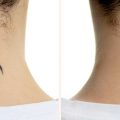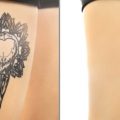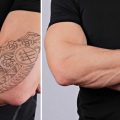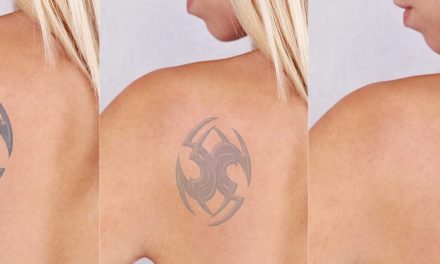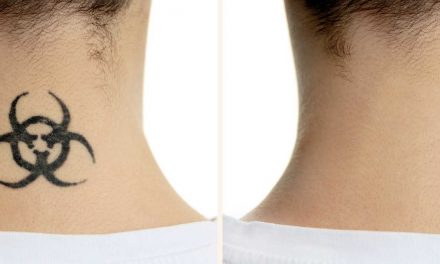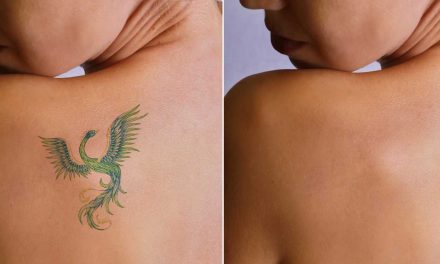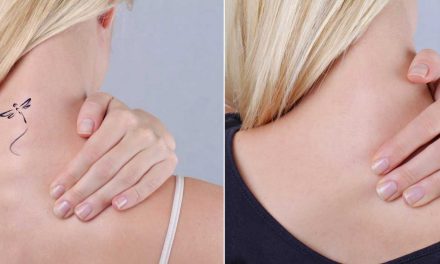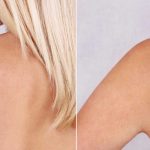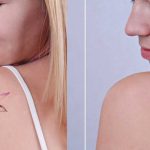Tattoos are means of self-expression for many people. It could just show your belonging to a particular group, or be a style statement or be in memory of your loved one. In a country like the US, body art is quite common for multiple reasons, but whatever the story behind the tattoo, they are generaly permanent.
If at any time you want to remove your tattoo, you need to accept the fact that it will not be easy. Why is this?
The Science Behind Tattooing
The skin basically has three layers, but here we are only concerned with the first two – the epidermis (the upper layer that you can see) and the dermis (the second layer right below the epidermis).
When tattooing, the machine injects ink through the upper layer of the skin into the dermis. This means that although the tattoo looks as though it is on the outer skin, it actually sits below the outer layer. Therefore, in order to remove it, any effort of yours must reach the dermis.
Are you looking for a way to remove your tattoo? You’re not alone. But three things must be troubling you when considering removal techniques. Is it effective? Is it safe? Is it expensive?
Let us look at the different options that are available within this context.
Permanent Solutions to Tattoo Removal
Over the years, these methods have evolved and developed with science. It is imperative to note that not all of these promise a safe or effective result.
Self-Administered Abrasive Methods
In this method, the tattooed skin is rubbed vigorously with sanding paper or a salt solution to scrape away the layers of the skin till the dermis is reached to remove the pigments. While the actual procedure includes three to four steps, for even the traces of the tattoo to be gotten rid of completely, repetitions of this process are needed.
This option is definitely inexpensive compared to some other procedures, but it scores very low in safety and effectiveness. It is true that the tattoo can fade or substantially lighten after abrasion but this happens after extreme bleeding and pain, and it is cruel to put yourself through this.
And in most cases, your tattoo is no longer visible not because it is absent but because it is covered by a huge scar. Not to mention that you could end up with a partly visible-partly faded tattoo which looks more like a mess and less like a work of art.
Using Natural Blends
With all the craze of going natural, even de-inking tattoo options have taken that route. Lemon, yogurt, aloe vera, honey, lavender essential oil and salt are all recommended as natural concoctions that can fade away tattoos.
While a number of such recipes are given on the internet, there are next to no records that they can magically vanish a tattoo. On the cost concern, this recommendation is not heavy on your pocket, but on the effectiveness front, it might not be satisfactory.
Store-Bought Tattoo Removal Creams
These chemical and natural creams are sold in the market as either a one-step or many stages treatment. They can be bought for as low as $30 up to around $100. For a cream or balm to work for tattoo fading, it has to first reach the dermis. Most tattoo fading creams are not able to do this. On the off-chance that it is possible, they end up fading the art but sometimes result in scarring or other side effects.
Tattoo removal creams are vigorously marketed and, at the same time, studiously discouraged by dermatologists. While there are no scientific records that they work, one can find a few positive reviews about them from people who proclaim to be users. If you plan to test these, a money back policy would be your insurance.
Tattoo Removal Machines and Lights for Home Use
These are laser and electrified machines that can be used at home for tattoo removal. Originally made for removing hair, pigment spots, moles, and tags, these machines are also advertised for tattoo fading and removal. Not all of such products are effective because they are not made for this exclusive purpose.
Devices that function differently are priced differently, but you can expect to pay at least $150. Incorrect knowledge and practices when you use these at home can very well result in scars, rashes or other infections.
Tattoo Skin Peels
Tattoo skin peels are accessible at around $10 a bottle. These are usually TCA (Tri Chloroacetic Acid) based and are meant to burn the top layers of the skin, forcing the body to heal with new skin.
Technically speaking, wrinkles, tanning, and acne scars are the problems these peels are used to target. Thus, these were not created for tattoos, and, in opposition to tanning and acne scars, which lie on the outer layers of the skin, tattoos are more internal. So logically, these peels have to be retained for a longer time to burn more skin layers.
The wearer faces a serious risk of scarring or discoloration if the procedure is done improperly or without appropriate guidance and, furthermore, the maximum these can do is fade your tattoo.
Surgical Excision
In surgical excision, the skin where the tattoo lies is removed with a scalpel and then stitches are used to seal the skin. This is usually recommended for smaller sized tattoos. The expense varies depending on the size of the tattooed area and the anesthesia used. If skin grafts are used, then you will incur additional cost. Excision is capable of removing the tattoo, but there is a high potential of scarring, infection, and disfigurement.
Dermabrasion by a Surgeon
A surgeon using rotating equipment scrapes away the skin with the tattoo. This is similar to salabrasion but is carried out by a professional. The expense can range from a few hundred dollars to thousands of dollars, depending on the size and age of the tattoo. If more than one session is needed, the cost escalates accordingly. The patient would take around two or three weeks to recover fully.
Dermabrasion is also used for other skin issues but in tattoo removal the procedure is done up to the skin level where the tattoo lies. Scarring, discoloration and skin infections are probable side effects of this technique.
Laser Treatment
The laser is probably the most recommended method of permanent tattoo removal. Performed by doctors, the tattooed skin is exposed to laser beams which alter the pigments of the tattoo in such a way that the body’s immune system can remove them. This treatment is done in stages with sufficient time in between. The laser is capable of targeting the tattooed area minutely, which differentiates this from the other methods.
There are different types of lasers of which the Q-switch is the one most commonly used. Laser surgery is bloodless and if done correctly has a minimal risk of scarring and infection.
The laser has been known to be effective provided certain factors of the tattoo and the skin are eligible. This can be judged by a professional. For one session of laser surgery, you might incur a cost of about $150 and on average you will need 6-12 sessions, which makes using the laser for tattoo removal expensive and beyond the reach of some especially at this is considered a cosmetic procedure which your insurance company might not cover.
The exact cost, however, is again dependent on many factors. Prepare Yourself – Set Practical Expectations
If you have decided to go for permanent tattoo removal, your journey is going to be easy only if you set realistic expectations of the results. The outcome is different for individual tattoos. Therefore showing your tattoo to professionals and discussing the options and probable results would prevent you from being disappointed and help you to consider your choices.
Tattoo Features and Its Removal
Understanding how the characteristics of the tattoo affect its de-inking can help you in evaluating your options better. These features are particularly important for laser removal, with a milder impact on some of the other techniques.
Size
The larger the tattoo, the more its removal is going to be a headache. If you are going for surgical procedures, then you will need fewer sessions if the tattoo is small, which also reduces the cost.
Color
If you choose laser removal then, depending on the number of colors, you will have to undergo sessions with a laser of different wavelengths, which increases the time taken.
Location
Where the tattoo is also determines how quickly it fades because of the role that blood circulation plays. Generally, those nearer to the heart are easier to remove than those further away. Also, the skin in some areas of the body is more sensitive and this can change the effectiveness of each method.
Age
As far as the laser is concerned, older tattoos are easier to remove than newer ones as they naturally tend to fade with age.
Skill of the Artist
In tattoos which have been done perfectly by professional artists, the ink tends to lie deeper, so de-inking is difficult. That said, professionally applied ink will tend to be at the same (deep) level, which can make it easier to deal with than those done at home or by amateurs where the pigment positioning is irregular.
Getting a Cover-Up Tattoo Done
Maybe you don’t like the quality of the tattoo that you have got done or maybe the tattoo has been distorted by age. Sometimes, you might just develop a dislike for a tattoo over a period of time. If you are not against the idea of a tattoo in general, then you can choose to cover it up permanently with another tattoo.
For this, the cover up tattoo should preferably be significantly darker and larger than the original one, and you will not have unrestricted freedom to choose your new tattoo. The most important criterion is that the artist must be even more skilled than the one who did your first tattoo, because camouflaging it with another design that still looks beautiful needs good creative and artistic talent.
Getting a cover up tattoo done is an effective and safe method to permanently hide an embarrassing tattoo, but it is only as safe and effective as the quality of the tattoo artist.
A cover up tattoo is not per se costly, but it would become expensive if you insist on a particular design which requires you to get a laser procedure done beforehand. It is difficult to estimate the actual cost as it is size and design dependent, but it should not cost much more than getting a normal tattoo because the chair time and aftercare is going to be much the same, with planning time a minor addition. The artist’s expertise would also decide the charge and it is a good idea to make enquiries and look at before and after photos before you choose this method.
So is tattoo removal safe, effective and inexpensive? It is tough to say. Despite the number of techniques out there to de-ink tattoos, each one is on a different scale in terms of safety, effectiveness and cost.
If you need to make a choice, then study each one as extensively as you can, not just over the internet but by conversing with doctors and experienced tattoo artists. The time a method takes or the cost involved should not be your only concern. Look for safety and effectiveness as well. Your decision today is going to affect your tomorrow, and that means you should give it the importance and caution it calls for.


